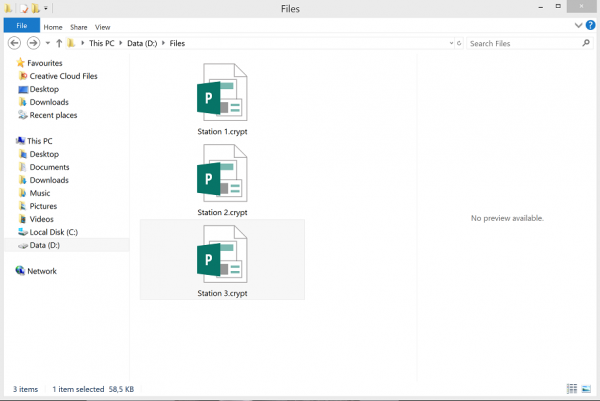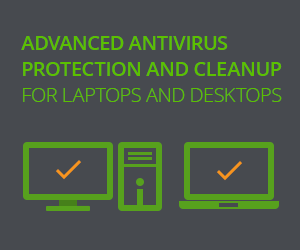Crypt ransomware virus owes its name to the file extension appended. Each item hit by the malware gets a new extension .crypt. It is not that one cannot read the affected files due to the above modification.

In fact, the solution would be pretty easy, had it involved removing the misleading extension only.
The piece of malware is a scrambling trojan. It deploys extra strong encryption algorithm rendering your data unreadable by virtue of changing their program code. The encoding standard is RSA-4096, which is widely used by the crooks to deprive their victims of the access to their data.
The scrambling generates both private and public keys. While it is relatively easy to intercept the latter, the former is kept secret. It never enters the computer system of a victim. Hence, there is no chance to learn it by tracking back the activities on the host PC.
Once the malicious modification of your data completes, the Crypt ransomware comes up with its ransom note. To ensure the victim is notified, the infection generates a de_crypt_readme file. The item exists in three formats so that there are definitely some software to process it. Besides, the infection tries to change desktop wallpaper to the same ransom note.
The message states the victim’s files have been protected. As you can see, they have actually been hijacked using a strong encryption system. The notification explains the background of the data encoding and requires the victim to visit the victim’s personal page. The page would further instruct its visitor to install and use TOR browser for transferring the amount of 1.2 Bitcoins to the hackers.
Upon receiving the fee via the specified payment channel, the crooks are to dispatch the private key along the decrypting software.
Please, barware the ransomware distribution involves a number of unrelated actors. They may simply fail to have an adequate proficiency to properly handle the transaction, but any bitcoin payments are non-refundable. The amount claimed by the criminal is1.2 BTC, which is circa 500 USD. It is to be doubled, if not received within 96 hours since the encryption virus started to run on a compromised machine.
Circumstances vary from case to case, but the general suggestion is to stick to ransom-free recovery routines.
The virus is also known as CryptXXX or CryptProjectXXX. Those names are more common among IT researchers as they refer to the binary code they have extracted from the malware.
As regards the ransomware circulation, most of the invasions occur as streaming video is being rendered. That makes it quite different from most of the ransomware strains that have been around.
Another distinctness inherent in the virus is the directory hosting the .crypt ransomware proper. The rogue drops its main executable into ProgramData folder, whereas most of its counterparts run from AppData or Temp. These are rather techie matters, though. What really matters for a victim is a method that can return the affected data to duly readable format. The paragraphs below highlight the most elaborate and efficient workarounds for the removal of Crypt file virus and ransom-free data recovery.
Automatic removal of .crypt ransomware
The benefits of using the automatic security suite to get rid of this infection are obvious: it scans the entire system and detects all potential fragments of the virus, so you are a few mouse clicks away from a complete fix.
- Download and install recommended malware security suite
- Select Start Computer Scan feature and wait until the utility comes up with the scan report. Proceed by clicking on the Fix Threats button, which will trigger a thorough removal process to address all the malware issues compromising your computer and your privacy.
Unlock .crypt files
.crypt represents a unique category of malicious software whose attack surface reaches beyond the operating system and its components, which is why removing the virus itself is a part of the fix only. As it has been mentioned, it encrypts one’s personal information, so the next phase of the overall remediation presupposes reinstating the files that will otherwise remain inaccessible.
-
Launch data recovery software
Similarly to the rest of its fellow-infections, .crypt most likely follows an operational algorithm where it erases the original versions of the victim’s files and actually encrypts their copies. This peculiarity might make your day, because forensics-focused applications like Data Recovery Pro are capable of restoring the information that has been removed. As the virus further evolves, its modus operandi may be altered – in the meanwhile, go ahead and try this.
-
Take advantage of Volume Shadow Copy Service
This technique is based on using the native backup functionality that’s shipped with Windows operating system. Also referred to as Volume Snapshot Service (VSS), this feature makes regular backups of the user’s files and keeps their most recent versions as long as System Restore is on. .crypt virus hasn’t been found to affect these copies therefore the restoration vector in question is strongly recommended. The two sub-sections below highlight the automatic and manual workflow.
- a) Use Shadow Explorer
Shadow Explorer is an applet that provides an easy way of retrieving previous versions of files and folders. Its pro’s include an intuitive interface where the computer’s entire file hierarchy is displayed within one window. Just pick the hard disk volume, select the object or directory to be restored, right-click on it and choose Export. Follow the app’s prompts to get the job done.

- b) Use file properties
Essentially, what the above-mentioned Shadow Explorer tool does is it automates the process that can otherwise be performed manually via the Properties dialog for individual files. This particular approach is more cumbrous but just as effective as its software-based counterpart, so you can proceed by right-clicking on a specific file, which has been encrypted by .crypt ransomware, and selecting Properties in the context menu. The tab named Previous Versions is the next thing to click – it displays available versions of the file by date of the snapshot creation. Pick the latest copy and complete the retrieval by following the prompts.

-
Data backups work wonders
Ransomware like .crypt isn’t nearly as almighty and destructive in case you run regular file backups to the cloud or external data media. The virus itself can be completely removed in a matter of minutes, and the distorted information can then be just as easily recovered from the backup. Luckily, this is a growing trend, so ransom Trojans are hopefully going to become less subversive in the near future.
Verify thoroughness of the removal
Having carried out the instructions above, add a finishing touch to the security procedure by running an additional computer scan to check for residual malware activity
